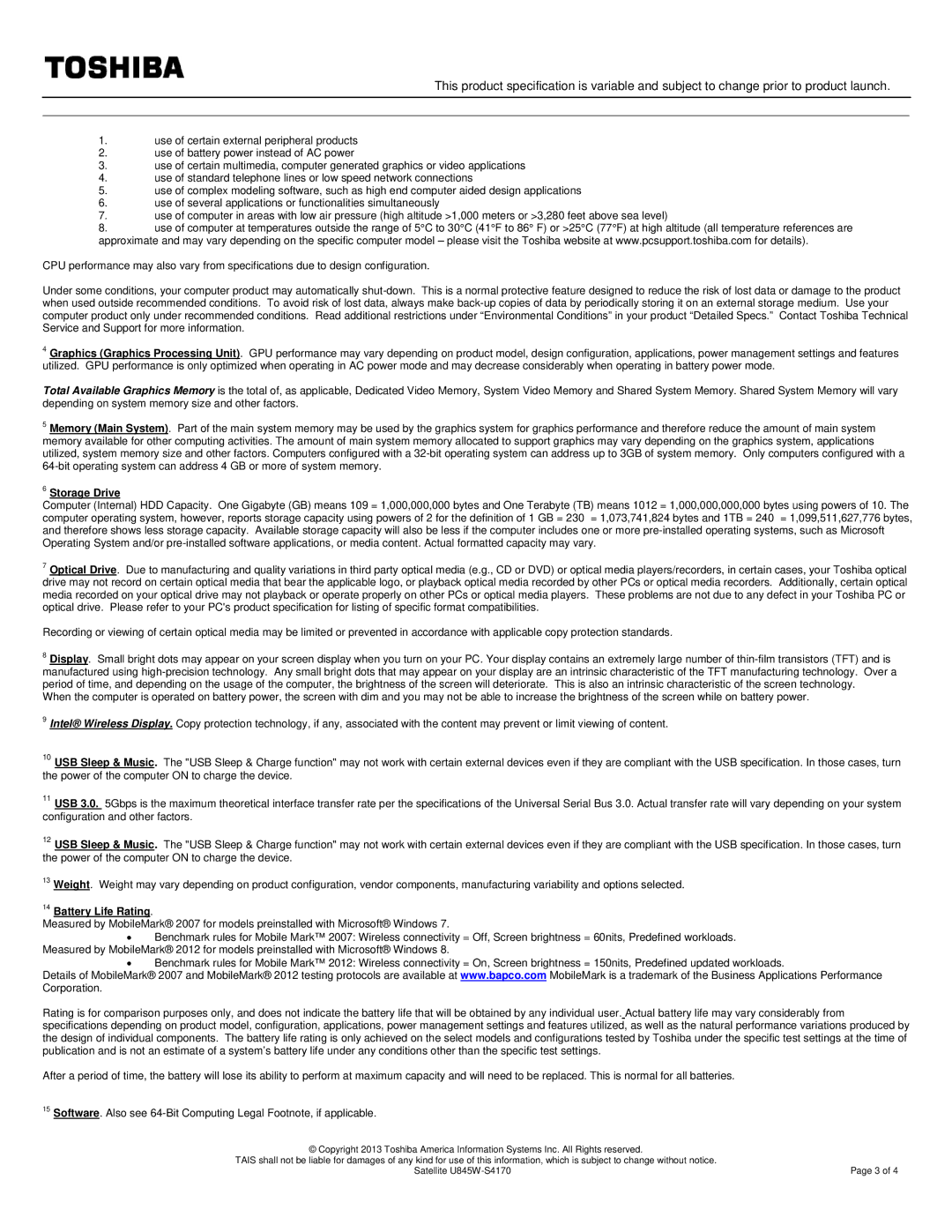
This product specification is variable and subject to change prior to product launch.
1.use of certain external peripheral products
2.use of battery power instead of AC power
3.use of certain multimedia, computer generated graphics or video applications
4.use of standard telephone lines or low speed network connections
5.use of complex modeling software, such as high end computer aided design applications
6.use of several applications or functionalities simultaneously
7.use of computer in areas with low air pressure (high altitude >1,000 meters or >3,280 feet above sea level)
8.use of computer at temperatures outside the range of 5°C to 30°C (41°F to 86° F) or >25°C (77°F) at high altitude (all temperature references are approximate and may vary depending on the specific computer model – please visit the Toshiba website at www.pcsupport.toshiba.com for details).
CPU performance may also vary from specifications due to design configuration.
Under some conditions, your computer product may automatically
4Graphics (Graphics Processing Unit). GPU performance may vary depending on product model, design configuration, applications, power management settings and features utilized. GPU performance is only optimized when operating in AC power mode and may decrease considerably when operating in battery power mode.
Total Available Graphics Memory is the total of, as applicable, Dedicated Video Memory, System Video Memory and Shared System Memory. Shared System Memory will vary depending on system memory size and other factors.
5Memory (Main System). Part of the main system memory may be used by the graphics system for graphics performance and therefore reduce the amount of main system memory available for other computing activities. The amount of main system memory allocated to support graphics may vary depending on the graphics system, applications utilized, system memory size and other factors. Computers configured with a
6Storage Drive
Computer (Internal) HDD Capacity. One Gigabyte (GB) means 109 = 1,000,000,000 bytes and One Terabyte (TB) means 1012 = 1,000,000,000,000 bytes using powers of 10. The computer operating system, however, reports storage capacity using powers of 2 for the definition of 1 GB = 230 = 1,073,741,824 bytes and 1TB = 240 = 1,099,511,627,776 bytes, and therefore shows less storage capacity. Available storage capacity will also be less if the computer includes one or more
7Optical Drive. Due to manufacturing and quality variations in third party optical media (e.g., CD or DVD) or optical media players/recorders, in certain cases, your Toshiba optical drive may not record on certain optical media that bear the applicable logo, or playback optical media recorded by other PCs or optical media recorders. Additionally, certain optical media recorded on your optical drive may not playback or operate properly on other PCs or optical media players. These problems are not due to any defect in your Toshiba PC or optical drive. Please refer to your PC's product specification for listing of specific format compatibilities.
Recording or viewing of certain optical media may be limited or prevented in accordance with applicable copy protection standards.
8Display. Small bright dots may appear on your screen display when you turn on your PC. Your display contains an extremely large number of
When the computer is operated on battery power, the screen with dim and you may not be able to increase the brightness of the screen while on battery power.
9Intel® Wireless Display. Copy protection technology, if any, associated with the content may prevent or limit viewing of content.
10USB Sleep & Music. The "USB Sleep & Charge function" may not work with certain external devices even if they are compliant with the USB specification. In those cases, turn the power of the computer ON to charge the device.
11USB 3.0. 5Gbps is the maximum theoretical interface transfer rate per the specifications of the Universal Serial Bus 3.0. Actual transfer rate will vary depending on your system configuration and other factors.
12USB Sleep & Music. The "USB Sleep & Charge function" may not work with certain external devices even if they are compliant with the USB specification. In those cases, turn the power of the computer ON to charge the device.
13Weight. Weight may vary depending on product configuration, vendor components, manufacturing variability and options selected.
14Battery Life Rating.
Measured by MobileMark® 2007 for models preinstalled with Microsoft® Windows 7.
Benchmark rules for Mobile Mark™ 2007: Wireless connectivity = Off, Screen brightness = 60nits, Predefined workloads. Measured by MobileMark® 2012 for models preinstalled with Microsoft® Windows 8.
Benchmark rules for Mobile Mark™ 2012: Wireless connectivity = On, Screen brightness = 150nits, Predefined updated workloads.
Details of MobileMark® 2007 and MobileMark® 2012 testing protocols are available at www.bapco.com MobileMark is a trademark of the Business Applications Performance Corporation.
Rating is for comparison purposes only, and does not indicate the battery life that will be obtained by any individual user. Actual battery life may vary considerably from specifications depending on product model, configuration, applications, power management settings and features utilized, as well as the natural performance variations produced by the design of individual components. The battery life rating is only achieved on the select models and configurations tested by Toshiba under the specific test settings at the time of publication and is not an estimate of a system’s battery life under any conditions other than the specific test settings.
After a period of time, the battery will lose its ability to perform at maximum capacity and will need to be replaced. This is normal for all batteries.
15 Software. Also see
© Copyright 2013 Toshiba America Information Systems Inc. All Rights reserved. |
|
TAIS shall not be liable for damages of any kind for use of this information, which is subject to change without notice. |
|
Satellite | Page 3 of 4 |
